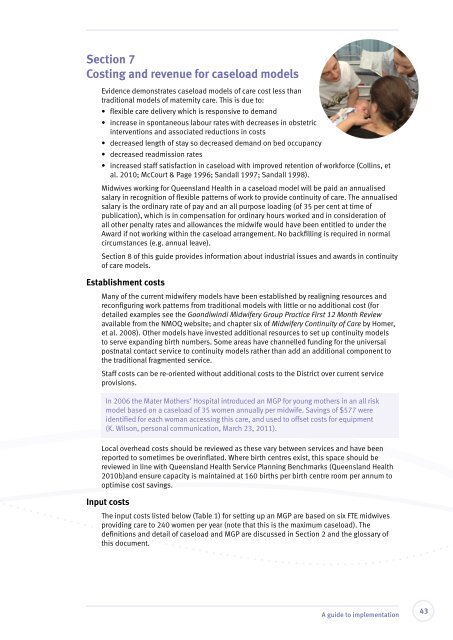Delivering continuity of midwifery care to Queensland women
Delivering continuity of midwifery care to Queensland women
Delivering continuity of midwifery care to Queensland women
Create successful ePaper yourself
Turn your PDF publications into a flip-book with our unique Google optimized e-Paper software.
Section 7<br />
Costing and revenue for caseload models<br />
Evidence demonstrates caseload models <strong>of</strong> <strong>care</strong> cost less than<br />
traditional models <strong>of</strong> maternity <strong>care</strong>. This is due <strong>to</strong>:<br />
• flexible <strong>care</strong> delivery which is responsive <strong>to</strong> demand<br />
• increase in spontaneous labour rates with decreases in obstetric<br />
interventions and associated reductions in costs<br />
• decreased length <strong>of</strong> stay so decreased demand on bed occupancy<br />
• decreased readmission rates<br />
• increased staff satisfaction in caseload with improved retention <strong>of</strong> workforce (Collins, et<br />
al. 2010; McCourt & Page 1996; Sandall 1997; Sandall 1998).<br />
Midwives working for <strong>Queensland</strong> Health in a caseload model will be paid an annualised<br />
salary in recognition <strong>of</strong> flexible patterns <strong>of</strong> work <strong>to</strong> provide <strong>continuity</strong> <strong>of</strong> <strong>care</strong>. The annualised<br />
salary is the ordinary rate <strong>of</strong> pay and an all purpose loading (<strong>of</strong> 35 per cent at time <strong>of</strong><br />
publication), which is in compensation for ordinary hours worked and in consideration <strong>of</strong><br />
all other penalty rates and allowances the midwife would have been entitled <strong>to</strong> under the<br />
Award if not working within the caseload arrangement. No backfilling is required in normal<br />
circumstances (e.g. annual leave).<br />
Section 8 <strong>of</strong> this guide provides information about industrial issues and awards in <strong>continuity</strong><br />
<strong>of</strong> <strong>care</strong> models.<br />
Establishment costs<br />
Many <strong>of</strong> the current <strong>midwifery</strong> models have been established by realigning resources and<br />
reconfiguring work patterns from traditional models with little or no additional cost (for<br />
detailed examples see the Goondiwindi Midwifery Group Practice First 12 Month Review<br />
available from the NMOQ website; and chapter six <strong>of</strong> Midwifery Continuity <strong>of</strong> Care by Homer,<br />
et al. 2008). Other models have invested additional resources <strong>to</strong> set up <strong>continuity</strong> models<br />
<strong>to</strong> serve expanding birth numbers. Some areas have channelled funding for the universal<br />
postnatal contact service <strong>to</strong> <strong>continuity</strong> models rather than add an additional component <strong>to</strong><br />
the traditional fragmented service.<br />
Staff costs can be re-oriented without additional costs <strong>to</strong> the District over current service<br />
provisions.<br />
In 2006 the Mater Mothers’ Hospital introduced an MGP for young mothers in an all risk<br />
model based on a caseload <strong>of</strong> 35 <strong>women</strong> annually per midwife. Savings <strong>of</strong> $577 were<br />
identified for each woman accessing this <strong>care</strong>, and used <strong>to</strong> <strong>of</strong>fset costs for equipment<br />
(K. Wilson, personal communication, March 23, 2011).<br />
Local overhead costs should be reviewed as these vary between services and have been<br />
reported <strong>to</strong> sometimes be overinflated. Where birth centres exist, this space should be<br />
reviewed in line with <strong>Queensland</strong> Health Service Planning Benchmarks (<strong>Queensland</strong> Health<br />
2010b)and ensure capacity is maintained at 160 births per birth centre room per annum <strong>to</strong><br />
optimise cost savings.<br />
Input costs<br />
The input costs listed below (Table 1) for setting up an MGP are based on six FTE midwives<br />
providing <strong>care</strong> <strong>to</strong> 240 <strong>women</strong> per year (note that this is the maximum caseload). The<br />
definitions and detail <strong>of</strong> caseload and MGP are discussed in Section 2 and the glossary <strong>of</strong><br />
this document.<br />
A guide <strong>to</strong> implementation<br />
43
















